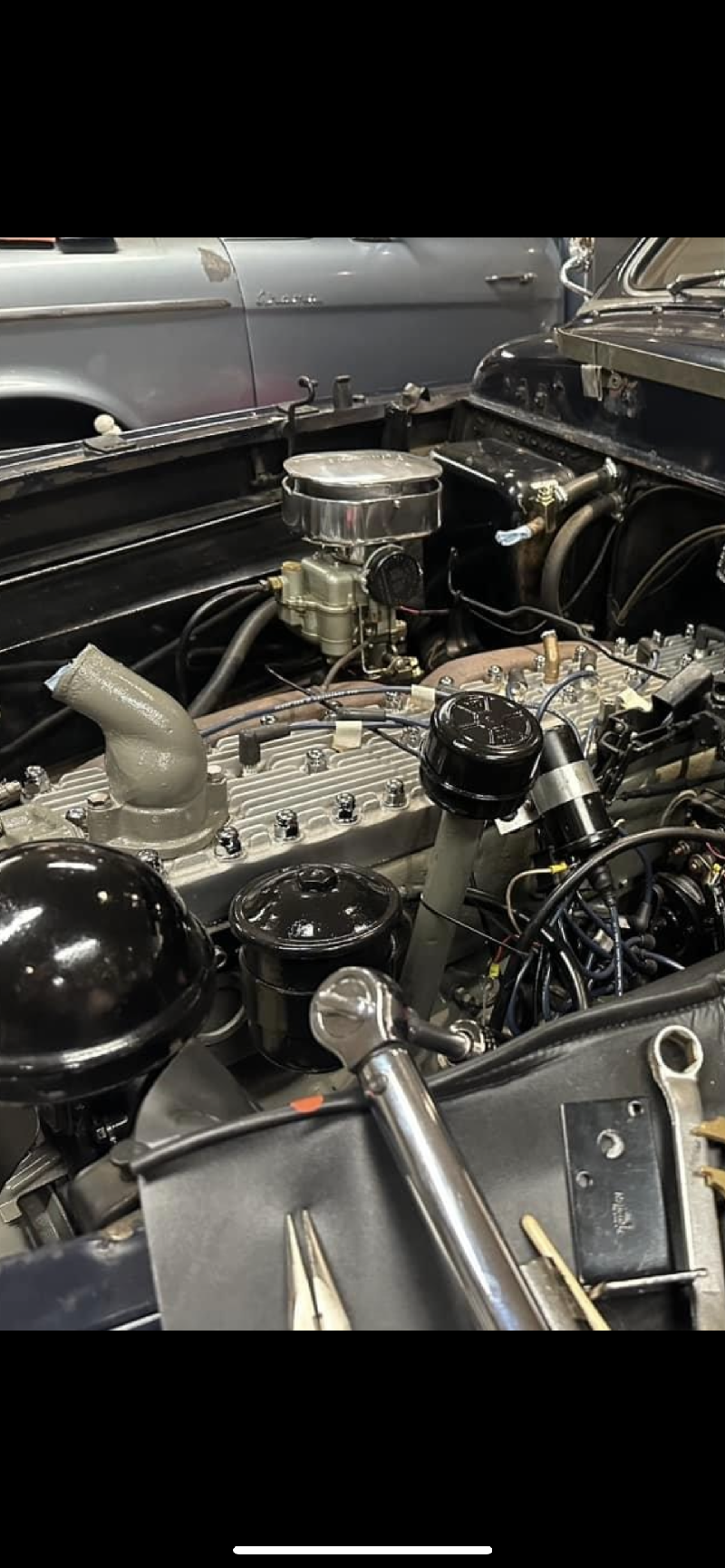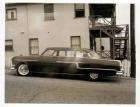|
Re: 356 CI Compression Ratio
|
||||
|---|---|---|---|---|
|
Just can't stay away
|
What we need for these straight 8’s are one of these!
Where can we get one?
Posted on: 2023/12/29 0:44
|
|||
|
||||
|
Re: 356 CI Compression Ratio
|
||||
|---|---|---|---|---|
|
Forum Ambassador
|
Keep looking!

Posted on: 2023/12/29 2:04
|
|||
|
Mal
/o[]o\ ====  Bowral, Southern Highlands of NSW, Australia "Out of chaos comes order" - Nietzsche. 1938 Eight Touring Sedan - SOLD 1941 One-Twenty Club Coupe - SOLD 1948 Super Eight Limo, chassis RHD - SOLD 1950 Eight Touring Sedan - SOLD What's this?  Put your Packard in the Packard Vehicle Registry! Here's how! Any questions - PM or email me at ozstatman@gmail.com |
||||
|
||||
|
Re: 356 CI Compression Ratio
|
||||
|---|---|---|---|---|
|
Home away from home
|
You have it backwards, Scott. Installing the heads from the smaller engine will raise the compression ratio on your 356 as the combustion chamber volumes are smaller. If you install a 53 327 head, the compression ratio will be approx. 8.7 and you will need to use premium fuel. A nice compromise would be a 7.5:1 head from an earlier 327 which would give you about 8.1.
Posted on: 2023/12/29 7:34
|
|||
|
||||
|
Re: 356 CI Compression Ratio
|
||||
|---|---|---|---|---|
|
Home away from home
|
FYI: over on the left, there's a '48 fact book, that lists the 356 compression as 7:1.
Posted on: 2023/12/29 9:41
|
|||
|
||||
|
Re: 356 CI Compression Ratio
|
||||
|---|---|---|---|---|
|
Home away from home

|
So the file posted on this site is incorrect?
https://packardinfo.com/xoops/html/downloads/Packard%20Heads%20Compression%20Ratios.pdf
Posted on: 2023/12/29 19:09
|
|||
|
1942 Clipper Club Sedan
1948 Custom Touring Sedan (22nd Series) 1955 Patrician Sedan 1955 Four Hundred Hardtop Coupe |
||||
|
||||
|
Re: 356 CI Compression Ratio
|
||||
|---|---|---|---|---|
|
Home away from home
|
The chart is confusing. The first column describes which engine the head is FROM. The next columns give the compression ratio that results if that head is installed on the other engines.
Posted on: 2023/12/29 19:50
|
|||
|
||||
|
Re: 356 CI Compression Ratio
|
||||
|---|---|---|---|---|
|
Home away from home
|
Scott, an aside in a late '47 Packard Service Counselor, which you can read here via Literature Archive, and we wish more posters would avail themselves of the exhaustive information Kev has provided instead of asking the same questions over and over. It suggested that for owners of 356-engined cars wanting a trace more oomph, the 327 cylinder head, which came out in April that year with the bathtub convertible since war prevented tooling the Clipper for dropheads and woodies. This gives 7.5:1 compression. There is also a chart here on PackardInfo showing which heads provide a given compression on interchange.
A lifelong Packard maven friend has a 288 head on his '42 One-Sixty convertible's 356 for 8:1, and it purrs, starts, restarts on the button--or tap of foot, though many of us have added underdash buttons in addition to our Carter Car Start accelerator switch. This helps when you only want to blip the starter as when trying to line up the timing mark. Studebaker put their starter switch under the clutch pedal, which seems smarter. A rule of thumb in the day was that all things being equal, an ohv engine could handle a full number higher compression, ie: 7:1, 8:1, than a flathead (L-head- valve-en-bloc) before pinging. So don't get carried away on boosting compression. An engine in good shape, well tuned, gives plenty of performance. Tho' Packard's mainstays were refinement and smoothness, their cars performed. My 8:1 friend and i both use regular 87 octane without a hitch. BTW, when Packard raised the 356's compression from 1940-41's 6.41:1 to 1942-'47's 6.85, they advertised 165 hp. instead of the previous 160. But despite later 356 bathtubs having an even 7:1, listed horsepower was back to 160. In 1940, Buick ran dyno tests of all cars remotely sales competitors at the GM Proving Grounds. Packard's 356 produced only 131 corrected hp, an overstatement of 22.10%. 1940 Cadillacs had the greatest variance between advertised and corrected hp than any other GM product, 135 vs. 118 (130 vs. 115 LaSalle), a Series 72 Cad's advertised 140 was really 124.5. '40 Lincoln Zephyr's adv. 120 was 104. The '40 Buick Century/Roadmaster/Limited claimed 141 was not so far off the real 130. Compound Carburetion was standard on all 320-ci-engined 1941-42 Buicks (Century, Roadmaster, Limited), with advertised hp. of 165. Buick in those days was even trouncing Cadillac in image, and was finally reined in after offering a handful of Brunn catalog customs. Buick and Cadillac were Packard's real threats, so much so that a year earlier Dutch Darrin observed, "Packard was so afraid of GM they couldn't see straight." 1941 traditional-bodied Packards were down 24% while the C-bodied '41 Buicks' and Cads' sales up the same percentage. Packard's five-year-old 1938 bodies, regardless facelifts in '40 and '41, were shopworn, box office poison, hence the dire need for the new Clipper, which was such a bellringer that in its truncated debut year it outsold the full year's production of less expensive One-Twenties, despite costing much more. If not for the war, largely Clipperized 1942 would've been Packard's biggest volume year since 1937, when they whored themselves silly purveying the funky little six. The 120 was a snappy Packard. The six should've been offered under another name. Either you're a fine car maker or you're not. 1940 was a good year thanks to big price cuts. I owned a '40 120. A good car, but lower quality than a '39 120. These were tough times for Packard, whose most profitable year ever was back in 1929, despite owning the infinitesimable fine car market (above $2,000 FOB) through 1936, and the 120 outselling all other junior cars, it the basis of all Packards other than 446 leftover Twelves from 1939-on. So, the last thing Packard was going to do was let Buick stand as the industry's most powerful car, hence 1942's 160/180 claiming an equal 165. After the war, Buick dropped the troublesome, thirsty, plug-fouling Compound Carburetion and dropped their listed hp back down to 144. So Packard could relax, return to their earlier 160. Short story, if you want to put a junior head on your 356, have at it. But don't expect a race car. And stick with the 6 degrees BTDC on timing, maybe a degree or two more given today's better, cleaner gasoline. But if you really want performance, get rid of all the dead weight you can, carry a couple extra pounds cold pressure in your tires, use 10W/30 full synthetic motor oil. The latter hasn't contained esters in many years, and those alone were what started decades ago the stories of drooling seals. A free-running, well-tuned engine, brakes not dragging, and you'll see what sold Packards off the showroom floor. Characters today doing cowboy stuff, focusing on the engine instead of the entire car. Ridiculous. Whatever you do, don't more than just clean up your head at the machine shop. Taking off too much interferes with combustion chamber shape and could even allow the valves to hit. A late friend ran a Packard-only shop, focusing on late '30s through '47. His slogan was "factory standard." At the risk of sounding like a broken record, i'm a sport car guy who fell under the spell of overdrive 1939-47 Packard 282/356 on the standard wb. No better road cars from either side of the Atlantic or Channel those years. Unfortunately, the B-O-P production men brought in to cost the 120--even Chevrolet's sales mgr. Bill Packer was recruited to teach Packard dealers how to sell on credit--- wound up running the Company. They knew production, but not marketing, which is why Packard's advertising became shrill, Mickey Rooney/Diana Durbin "Hey, kids, let's put on a show in the barn," 1940's "It's happening on a 1,000 Main Streets" against Buick and Cadillac's sauve Constance Bennett/Cary Grant confident sophistication. Any competent copywriter knows people aspire to what the folks atop the hill drive, not Main Street. Longer story short, these same one-trick ponies could later do no better than ape dreck like the Olds Fiesta, Buick Skylark, Cadillac Eldorado with the Caribbean, a stock convertible laden with another 200 lbs. of "sporty cues." The Packard of yore, the Packard who produced the '34 Lebaron sport coupes, would've anticipated, even trumped the '52 Bentley Continental. Do not understand these characters wanting to add air conditioning to Packards. Packard offered such because that's the car biz. If you really want a nice old road car, the l a s t thing you want to do is burden your engine with power-robbing accessories. You have a cowl vent and vent windows. Bottom line, factory standard and lose weight.
Posted on: 2023/12/29 22:52
|
|||
|
||||
|
Re: 356 CI Compression Ratio
|
||||
|---|---|---|---|---|
|
Home away from home

|
Quote:
That is confusing, but I see it now. So a '48-'52 327 head will bring the 356 from 6.85 to 7.53. Anything else would be excessive for a flathead running regular. Note that I'm not thinking in terms of HP, per se, but as I said, efficiency. I would expect fuel economy to be improved a little. What are the distinguishing marks on the '48-'52 327 head to differentiate it from the others?
Posted on: 2023/12/30 0:37
|
|||
|
1942 Clipper Club Sedan
1948 Custom Touring Sedan (22nd Series) 1955 Patrician Sedan 1955 Four Hundred Hardtop Coupe |
||||
|
||||
|
Re: 356 CI Compression Ratio
|
||||
|---|---|---|---|---|
|
Home away from home
|
Concerning advertising, Packard made some adjustments when marketing the 110 and 120 lines in an attempt to achieve a broader popular appeal. The also revised and (to my thinking) improved owner's manuals for the junior lines, since they expected 110 and 120 owners to be more likely to drive and service their own cars as compared with Senior model customers.
Most all automotive advertising changed in the 1930s, with more color and emphasis on style, comfort, features, and performance, along with more contemporary vocabulary and less emphasis on technical aspects. In the USA, the whole automotive scene was different in the 1930s and beyond as compared with earlier times. Roads were better, and traffic was heavier and faster, and more and more people demanded more than basic transportation, even in low priced cars. A great many people already had cars, and a good many had owned several, and they were looking for a BETTER car than what they had been used to. Advertising was reaching most people via radio and newspapers and popular magazines, and not just those who read National Geographic, Literary Digest, or Country Living. In my opinion, many of today's TV car ads are the worst ever, with many of them having much in common with MTV video rubbish.
Posted on: 2023/12/30 12:54
|
|||
|
||||

 755928D7-243C-4683-8F79-96E928766A21.png (1,639.79 KB)
755928D7-243C-4683-8F79-96E928766A21.png (1,639.79 KB)







